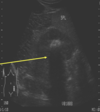Urinary Tract Problems & PUPD in the Horse Flashcards
(103 cards)
what is the water maintenance requirements in the horse
40-60 ml/kg bwt/day
what would a polydipsic horse be drinking a day
>100 ml/kg/day
what is a normal urine output
15-30 ml/kg bwt/day
15l for a 500kg horse
what are the ddx for PUPD (5)
- psychogenic PUPD
- secondary renal medullary washout
- endocrine: Cushing’s syndrome
- chronic renal failure
- diabetes insipidus (rare)
what are the causes of psychogenic PUPD
boredem/change of environment/feed
what is secondary renal medullary washout
inability to concentrate urine due to loss of sodium in renal medulla
how does cushing’s cause PUPD
direct inhibition of ADH
glucosuria
how does chronic renal failure lead to PUPD
increased water intake to maintain glomerular filtration rate
what are the types of diabetes insipidus
central vs nephrogenic
both very rare
what are the ways water is lost in equine
urine +/- 20%
feces +/- 75%
sweat
what is the normal colour of adult urine
pale yellow to brown
what is the normal colour of foal urine
pale yellow
what is the normal viscosity of adult urine
viscous (mucoid)
what is the normal viscosity of foal urine
watery
what is the normal transparency of adult urine
slightly turbid
what is the normal transparency of foal urine
translucent
what is the specific gravity of adult urine
1.006-1.050 (usually 1.020-1.050)
what would the specific gravity be if BUN elevated
>1.020 if BUN increased
what is the normal specific gravity of foal urine
1.001-1.027
what is the pH of adult urine
6.5-8.0
what is the pH of foal urine
6.0-7.0
what is the RBC/hpf in adult horse
<5 cells/hpf
what is the RBC/hpf in foal
none
what is the WBC/hpf in foal
0-3/hpf







